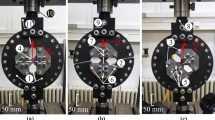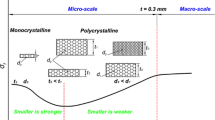Abstract
The kinematic contribution to the hardening of ultra-thin metallic sheets characterized by monotonic and reversed simple shear tests is of high interest in the sheet metal forming industry, because of its influence on the accurate prediction of springback. However, ultra-thin sheets are very sensitive to buckling when submitted to shear stress because of the large gauge width to thickness ratio, the stress perturbations induced by the clamping and the alignment of sample, which thus limit the attainable strain levels using conventional simple shear devices. In this paper, a new simple shear test dedicated to ultra-thin metallic sheets is proposed through the development of a specific support. A transparent glass part enables the application of a normal tightening force to prevent the out-of-plane buckling of the sheets whilst also allowing full field strain measurements to be taken. Firstly, the capabilities of the device are shown by comparing the mechanical behavior in a simple shear test on an austenitic stainless steel with and without the support. A good reproducibility of the flow curves is observed with the support and large shear strains are reached without buckling. Secondly, the influence of friction due to the contact between the sample and the support is checked by finite elements simulations and shown to be negligible compared to the shearing force. Finally, monotonic and reversed shear tests on a pure copper sheet with a thickness of 0.1 mm were performed up to rupture without buckling, these were not previously conceivable on such a low thichness, and demonstrate the potential of the proposed device.










Similar content being viewed by others
References
Vollertsen F, Schulze Niehoff H, Hu Z (2006) State of the art in micro forming. Int J Mach Tools Manuf 46:1172–1179
Weiss B, Gröger V, Khatibi G, Kotas A, Zimprich P, Stickler R, Zagar B (2002) Characterization of mechanical and thermal properties of thin cu foils and wires. Sensors Actuators A Phys 99:172–182
Engel U, Eckstein R (2002) Microforming - from basic research to its realization. J Mater Process Technol 125–126:35–44
Tsai M, Chen Y, Wu C, Chen F (2005) Size-effects in micro-metal sheet forming of unalloyed copper and brass. Adv Mater Res 6–8:705–712
Gau JT, Principe C, Yu M (2007) Springback behavior of brass in micro sheet forming. J Mater Process Technol 191:7–10
Kals TA, Eckstein R (2000) Miniaturization in sheet metal working. J Mater Process Technol 103:95–101
Costache E, Nanu N, Chirita B, Brabie G (2013) Prediction and prevention of material cracking in the case of micro or milli drawn parts made from aluminium foils. Int J Mech Sci 69:125–140
Peng L, Hu P, Lai X, Mei D, Ni J (2009) Investigation of micro/meso sheet soft punch stamping process - simulation and experiments. Mater Des 30:783–790
Fu MW, Chan WL (2012) A review on the state-of-the-art microforming technologies. Int J Adv Manuf Technol 67:2411–2437
Qin Y, Ma Y, Harrison CS, Brockett A, Zhou M, Zhao J, Law F, Razali A, Smith R, Eguia J (2008) Develoment of a new machine system for the forming of micro-sheet products. Int J Mater Form Suppl 1:475–478
Razali AR, Qin Y (2013) A review on micro-manufacturing, micro-forming and their key issues. Procedia Engineering 53:665–672
Fu M, Yang B, Chan W (2013) Experimental and simulation studies of micro blanking and deep drawing compound process using copper sheet. J Mater Process Technol 213:101–110
Michel JF, Picart P (2003) Size effects on the constitutive behavior for brass in sheet metal forming. J Mater Process Technol 141:439–446
Vollertsen F, Biermann D, Hansen HN, Jawahir IS, Kuzman K (2009) Size effects in manufacturing of metallic components. CIRP Ann Manuf Technol 58:566–587
Dodd B, Bai Y (1987) Ductile fracture and ductility. Academic Press, London, pp 2–28
Tiesler N (2002) Microforming size effects in friction and their influence on extrusion processes. Wire 1:34–38
Ragai I, Lazim D, Nemes JA (2005) Anisotropy and springback in draw-bending of stainless steel 410: experimental and numerical study. J Mater Process Technol 166:116–127
Kuwabara T, Kumanto Y, Ziegelheim J, Kurasaki I (2009) Tension-compression asymmetry of phosphor bronze for electric parts and its effect on bending behaviour. Int J Plast 25:1759– 1776
Libura T, Kowalewski ZL, Dietrich L, Socha G (2016) Anti-buckling system for flat specimens investigations under cyclic tension-compression. Materials Today: Proceedings 3:1045–1050
Boger RK, Wagoner RH, Barlat F, Lee MG, Chung K (2005) Continuous, large strain, tension/compression testing of sheet material. Int J Plast 21:2319–2343
Cao J, Lee W, Cheng HS, Seniw M, Wang HP, Czung K (2009) Experimental and numerical investigation of combined isotropic-kinematic hardening behaviour of sheet metals. Int J Plast 25:942–972
Knoerr L, Sever N, McKune P, Faath T (2014) Cyclic tension compression testing of AHSS flat specimens with digital image correlation system. AIP Conf Proc 1567:654–658
Chen Z, Maekawa S, Takeda T (1999) Bauschinger effect and multiaxial yield behavior of stress-reversed mild steel. Metall Mater Trans A 30:3069–3078
Brown GM (1970) Inelastic deformation of an aluminum alloy under combined stress at elevated temperature. J Mech Phys Solids 18:383–396
Wu PD, Neale KW, Van der Giessen E (1996) Simulation of the behaviour of fcc polycrystals during reversed torsion. Int J Plast 12:1199–1219
Manach PY, Couty N (2002) Elastoviscohysteresis constitutive law in convected coordinate frames: application to finite deformation shear tests. Comput Mech 28:17–25
Bouvier S, Haddadi H, Levee P, Teodosiu C (2006) Simple shear tests: experimental techniques and characterization of the plastic anisotropy of rolled sheets at large strains. J Mater Process Technol 172:96–103
Thuillier S, Manach PY (2009) Comparison of the work-hardening of metallic sheets using tensile and shear strain paths. Int J Plast 25:733–751
Boni S, G’Sell C (1982) Microscopic in situ observation of the plastic deformation of polybutene-1 films under simple shear. Polym Test 3:3–24
Pham CH, Thuillier S, Manach PY (2015) Mechanical properties involved in the micro-forming of ultra-thin stainless steel sheets. Metall Mater Trans A 46:3502–3515
Southwell RV, Skan SW (1924) On the stability under shearing forces of a flat elastic strip. Proc R Soc Lond 105:582–607
Chen B, Sivakumaran K (2011) Post-buckling shear strength of thin steel plates. Procedia Engineering 14:641–647
Weiss M, Kupke A, Manach PY, Galdos L, Hodgson PD (2015) On the Bauschinger effect in dual phase steel at high levels of strain. Mater Sci Eng A 643:127–136
Geng L, Wagoner RH (2002) Role of plastic anisotropy and its evolution on springback. Int J Mech Sci 44:123–148
Eggertsen P-A, Mattiasson K (2009) On the modelling of the bending-unbending behaviour for accurate springback predictions. Int J Mech Sci 51:547–563
Proudhon H, Poole WJ, Wang X, Brechet Y (2008) The role of internal stresses on the plastic deformation of the Al–Mg–Si–Cu alloy AA6111. Phil Mag 88:621–640
Acknowledgments
The French Agence Nationale de la Recherche (ANR) is gratefully acknowledged for funding this work under the project ANR-12-RMNP-0009-02 as well as Delta Composants for providing the materials. The authors would like to thank A. Jégat for his collaboration and S. Thuillier for the useful discussions.
Author information
Authors and Affiliations
Corresponding author
Rights and permissions
About this article
Cite this article
Pham, C., Adzima, F., Coër, J. et al. Anti-Buckling Device for Ultra-Thin Metallic Sheets Under Large and Reversed Shear Strain Paths. Exp Mech 57, 593–602 (2017). https://doi.org/10.1007/s11340-017-0256-4
Received:
Accepted:
Published:
Issue Date:
DOI: https://doi.org/10.1007/s11340-017-0256-4




